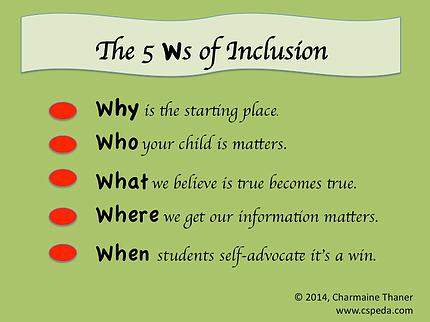The 5 Ws of Inclusion
Knowing your child is capable of so much more than what others give him credit for can be heartbreaking. Playing with your child, seeing his sense of humor and wishing others could see this side of him leaves you sad. Being proud of his determination and wondering why others don’t appreciate this is upsetting. Helping him with his homework and once again realizing no one is taking the time to modify his work so he can actually show what he knows, is beyond frustrating.
Keep reading to learn how to use the 5 Ws of Inclusion to be a change maker!
Think like a two-year old and always ask why.
- Begin with your child’s story. Communicate the WHY, the value of inclusive education and how it will impact your child’s life now and in the future.
- Practice painting a picture with your words, of your WHY for inclusion. You will be more confident explaining your vision to others.
- In order to win people’s hearts and minds, you begin with their hearts – the WHY.
Your child’s disability label is only one small characteristic of him.
- The only label that really counts is your child’s name!
- The next time you have to fill out a form about your child and there is a space for “label” write your child’s name in the blank – it is a quiet but impactful way to help others change their thinking.
- Have you told your child why his classmates need him, what he has to offer to his family, neighborhood and community?
- Each person needs to know that WHO they are matters. Our sons and daughters are often on the receiving end of support and don’t realize they bring important and needed gifts and talents to communities.
- Your child is more than all the initials of his disability labels.
- So, stop using those labels and initials when introducing our child to teachers and classmates. Instead help others get to know WHO your child is by having them learn about what he loves to do on weekends, his favorite books and TV shows, how you can tell when he is content or frustrated, the best ways to communicate with him, etc.
What we believe is true becomes true.
- WHAT your child hears about himself, WHAT you share about him with staff members, and WHAT you believe is possible for your child makes all the difference in the world.
- Do you share your high expectations of your child, academically and socially with your child, other family members and his teachers?
- Hold tight to your dreams. Believe in possibilities. Show your child their dreams count.
Listen to peers to gain insight.
- WHERE you get your information matters.
- Stop only having meetings with the adults at school trying to come up with a list of your child’s strengths, new ideas to try, etc.
- Invite classmates who know the student to share what they have learned with and from your child. Friends can often come up with more and better ideas than a group of adults sitting around a conference table. Try it!
Every child needs to know they are worthy, loved, and enough.
WHEN your son or daughter knows:
- his/her life has purpose;
- their voice matters;
- their dreams count;
- and they were born to make an impact,
- they can start becoming their own advocates for inclusion.
Change is possible. Let’s make it happen!
